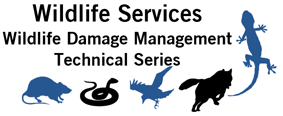United States Department of Agriculture: Animal and Plant Health Inspection Service

Wildlife Damage Management Technical Series
Date of this Version
7-2018
Document Type
Article
Citation
Mengak, M.T. 2018. Wildlife Translocation. Wildlife Damage Management Technical Series. USDA, APHIS, WS National Wildlife Research Center. Fort Collins, Colorado. 15p.
Abstract
Many people enjoy wildlife. It enriches their lives in many ways. Nationwide, Americans spend over $144 billion annually on fishing, hunting, and wildlife-watching activities. However, wildlife is not always welcome in or near homes, buildings, or other property and can cause significant damage or health and safety issues (Figure 1). In one study, 42% of urban residents reported experiencing a wildlife problem during the previous year and more than half of them said their attempts to resolve the problem were unsuccessful. Many people who experience a wildlife conflict prefer to resolve the issue without harming the offending animal. Of the many options available (i.e., habitat modification, exclusion, repellents) for addressing nuisance wildlife problems, translocation— capturing and moving—of the offending animal is often perceived to be effective. However, trapping and translocating wild animals is rarely legal nor is it considered a viable solution by wildlife professionals for resolving most nuisance wildlife problems. Reasons to avoid translocating nuisance wildlife include legal restrictions, disease concerns, liability issues associated with injuries or damage caused by a translocated animal, stress to the animal, homing behavior, and risk of death to the animal.
Hard release: A release method that simply turns a captured animal loose at a release site. The animal is not allowed to acclimate to the new environment and no additional resources, such as food, are provided. Homing: An animal’s ability to return to the location where it was originally captured following translocation.
Reintroduction: Releasing captive bred animals into a wild population, especially with reference to threatened or endangered species. Also used by state fish and game agencies to describe management activities that restore a native species to its formerly occupied habitat or range.
Relocation: To move an animal or family group from one location within its home range to another location within the same home range for the purpose of resolving a human-wildlife conflict. For example, a squirrel caught in an attic would be relocated to the backyard of the same home.
Soft release: A release method that involves an animal being maintained in an enclosed area or pen at the release site for a period of acclimation before release. After the animal is released, it may be given additional assistance, such as food provisions at or near the release site.
Translocation: The intentional capture and release of animals to the wild to establish, reestablish, or augment a population. Often synonymous with restock, augment, supplement, or reintroduction, especially from captive breeding efforts, but does not apply to nuisance wildlife or wildlife damage management situations.
Included in
Behavior and Ethology Commons, Biodiversity Commons, Other Animal Sciences Commons, Other Ecology and Evolutionary Biology Commons, Population Biology Commons, Terrestrial and Aquatic Ecology Commons


Comments
Published by USDA.